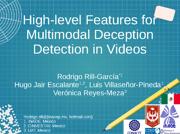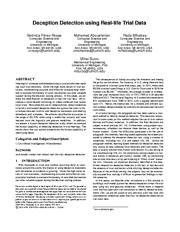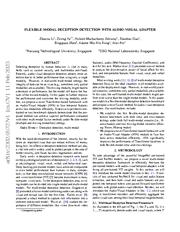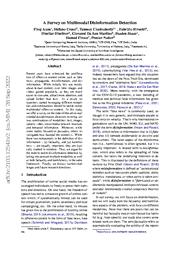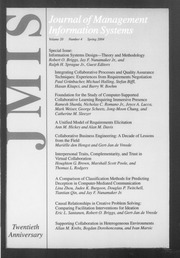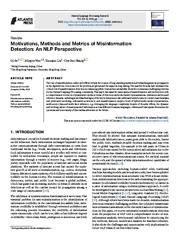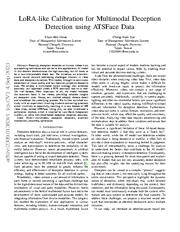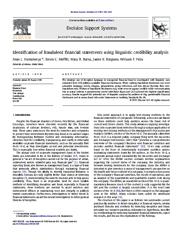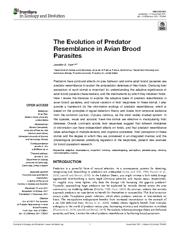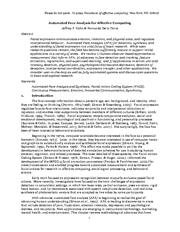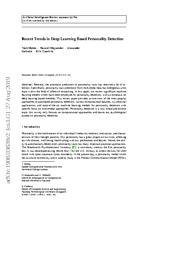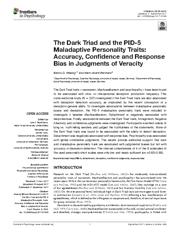A copy of this work was available on the public web and has been preserved in the Wayback Machine. The capture dates from 2020; you can also visit the original URL.
The file type is application/pdf.
Filters
High-Level Features for Multimodal Deception Detection in Videos
2019
2019 IEEE/CVF Conference on Computer Vision and Pattern Recognition Workshops (CVPRW)
multimodal information fusion method, inspired by classifier ensemble techniques, for deception detection in videos using high-level features • "Detecting deceptive behavior via integration of discriminative ...
features from multiple modalities" [2] -Physiological features, thermal videos and transcriptions -Early fusion -Fused non-invasive features surpassed physiological ones • "Deception detection using ...
Fusion Results Court
Future work • To explore LSTM networks for temporal analysis of features ...
doi:10.1109/cvprw.2019.00198
dblp:conf/cvpr/Rill-GarciaEPR19
fatcat:ewo7ts77tvdqjhq45efs3n64ge
Deception Detection using Real-life Trial Data
2015
Proceedings of the 2015 ACM on International Conference on Multimodal Interaction - ICMI '15
We explore the use of verbal and non-verbal modalities to build a multimodal deception detection system that aims to discriminate between truthful and deceptive statements provided by defendants and witnesses ...
We achieve classification accuracies in the range of 60-75% when using a model that extracts and fuses features from the linguistic and gesture modalities. ...
Any opinions, findings, and conclusions or recommendations expressed in this material are those of the authors and do not necessarily reflect the views of the National Science Foundation, the John Templeton ...
doi:10.1145/2818346.2820758
dblp:conf/icmi/Perez-RosasAMB15
fatcat:3omdyjyoezcb7m4fs4zgb5vj5i
Flexible-modal Deception Detection with Audio-Visual Adapter
[article]
2023
arXiv
pre-print
Detecting deception by human behaviors is vital in many fields such as custom security and multimedia anti-fraud. ...
However, in real-world multi-modal settings, the integrity of data can be an issue (e.g., sometimes only partial modalities are available). ...
[11] presented a novel method to analyze the discriminative power of facial affect for this task, and interpretable features from visual, vocal, and verbal modalities. ...
arXiv:2302.05727v1
fatcat:r5bhlyxlhzf4vc2rehspwqr5y4
A Survey on Multimodal Disinformation Detection
[article]
2022
arXiv
pre-print
Thus, we argue for the need to tackle disinformation detection by taking into account multiple modalities as well as both factuality and harmfulness, in the same framework. ...
In this study, we offer a survey on the state-of-the-art on multimodal disinformation detection covering various combinations of modalities: text, images, speech, video, social media network structure, ...
Limitations We might not have covered all relevant work that falls under the topics of factuality and harmfulness across different modalities. ...
arXiv:2103.12541v2
fatcat:dejuovchzngprf472wcgqvm7mq
A Comparison of Classification Methods for Predicting Deception in Computer-Mediated Communication
2004
Journal of Management Information Systems
Detecting deceit via analysis of verbal and nonverbal behavior. Journal of Nonverbal Behavior, 24, 4 (2000), 239-263.
c 373
PREDICTING DECEPTION IN COMPUTER-MEDIATED COMMUNICATION _ 165
38. ...
Some progress has been made in identifying and automatically deriving deception indicators from text by integrating findings and methods from multiple relevant disciplines, including natural language processing ...
doi:10.1080/07421222.2004.11045779
fatcat:7rkl3hy3nnbm7d4ft5imzubknu
Motivations, Methods and Metrics of Misinformation Detection: An NLP Perspective
2020
Natural Language Processing Research
This paper discusses the main issues of misinformation and its detection with a comprehensive review on representative works in terms of detection methods, feature representations, evaluation metrics and ...
Alternative solutions to anti-misinformation imply a trend of hybrid multi-modal representation, multi-source data and multi-facet inference, e.g., leveraging the language complexity. ...
ACKNOWLEDGMENTS We are grateful to the anonymous reviewers for their valuable and constructional advices on the previous versions of this article; all remaining errors are our own. ...
doi:10.2991/nlpr.d.200522.001
fatcat:vwwspvaexbga3kn5mxtdo6ke6u
LoRA-like Calibration for Multimodal Deception Detection using ATSFace Data
[article]
2023
arXiv
pre-print
This model, through its continuous assessment of visual, audio, and text features, pinpoints deceptive cues. ...
Recently, deception detection on human videos is an eye-catching techniques and can serve lots applications. ...
However, recent advancements in the field of multimodal fusion have led to the development of more sophisticated and accurate models for integrating information from diverse modalities. ...
arXiv:2309.01383v1
fatcat:jbk53ebnbjehvpmewkflyancgi
Identification of fraudulent financial statements using linguistic credibility analysis
2011
Decision Support Systems
The strategic use of deceptive language in managerial financial fraud is investigated with linguistic cues extracted from 202 publicly available financial disclosures. ...
Writers of fraudulent disclosures may write more to appear credible while communicating less in actual content. ...
Acknowledgement We are pleased to acknowledge the generous support from PricewaterhouseCoopers' INQuiries Research Grant. ...
doi:10.1016/j.dss.2010.08.009
fatcat:vxuneg2lyrenvdkgxq6tknuh2y
Learning to See the Hook: Comparing Phishing Training Approaches
2019
International Conference on Information Systems
We also uncover the mechanisms through which these training programs improve phishing detection and offer a new integrated phishing training method. ...
Our empirical results indicate that an integrated training program that combines mindfulness concepts, and targets specific linguistic identifiers of phishing, provide the greatest improvements to phishing ...
Rather than deriving detection rules from a theoretical domain of "all deceptive e-mails", a more precise approach considers only deceptive e-mails that are likely to be received. ...
dblp:conf/icis/HarrisonSSCZD19
fatcat:r4ijiiespjarjp5n5db4eie6wu
Emerging Biometrics: Deep Inference and Other Computational Intelligence
[article]
2020
arXiv
pre-print
Computational intelligence applications that cover a wide spectrum of biometric tasks using physiological and behavioral traits are chosen for illustration. ...
Biometric-enabled systems are evolving towards deep learning and deep inference using the principles of adaptive computing, - the front tides of the modern computational intelligence domain. ...
Acknowledgment This project was partially supported by Natural Sciences and Engineering Research Council of Canada (NSERC) through the grant "Biometric intelligent interfaces". ...
arXiv:2006.11971v1
fatcat:k6aunuoxc5apbb347vy2lj7bsq
The Evolution of Predator Resemblance in Avian Brood Parasites
2021
Frontiers in Ecology and Evolution
I also provide a framework for the information ecology of predator resemblance, which is based on the principles of signal detection theory and draws from empirical evidence from the common cuckoo, Cuculus ...
Overall, contrasts across host responses suggest that different modalities of information can have independent effects on hosts, and that predator resemblance takes advantage of multiple sensory and cognitive ...
How well prey can separate a hawk from background environmental noise (detection) is analogous to how well a host can discern between cuckoo and hawk (discrimination), since both processes are influenced ...
doi:10.3389/fevo.2021.725842
fatcat:x7cpjyxeera47ifbzwwf7pdgni
Preserving Integrity in Online Social Networks
[article]
2020
arXiv
pre-print
This survey comes from the perspective of having to combat a broad spectrum of integrity violations at Facebook. ...
This paper surveys the state of the art in keeping online platforms and their users safe from such harm, also known as the problem of preserving integrity. ...
To get a more holistic understanding of the post, WPIE is pretrained across multiple modalities, multiple integrity violations and over time. ...
arXiv:2009.10311v3
fatcat:4zltxel7zreb5a5nedpmlqwbli
Automated Face Analysis for Affective Computing
[chapter]
2015
The Oxford Handbook of Affective Computing
action unit and intensity detection, physical pain, psychological distress and depression, detection of deception, interpersonal coordination, expression transfer, and other applications. ...
Automated Face Analysis (AFA) for detection, synthesis, and understanding of facial expression is a vital focus of basic research. ...
The content is solely the responsibility of the authors and does not necessarily represent the official views of the NIH or ARL. ...
doi:10.1093/oxfordhb/9780199942237.013.020
fatcat:qrhzadx6y5bxzjo6nnfshhwoze
Recent Trends in Deep Learning Based Personality Detection
[article]
2019
arXiv
pre-print
Specifically, personality trait prediction from multimodal data has emerged as a hot topic within the field of affective computing. ...
This review paper provides an overview of the most popular approaches to automated personality detection, various computational datasets, its industrial applications, and state-of-the-art machine learning ...
Features are extracted from each of the 3 modalities using CNNs. ...
arXiv:1908.03628v2
fatcat:c2q6opil5rcxzbb7dolfbg5zqu
The Dark Triad and the PID-5 Maladaptive Personality Traits: Accuracy, Confidence and Response Bias in Judgments of Veracity
2017
Frontiers in Psychology
This cross-sectional study (N = 207) investigated if the Dark Triad traits are also associated with deception detection accuracy, as implicated by the recent conception of a deception-general ability. ...
None of the Dark Triad traits was found to be associated with the ability to detect deception. Detachment was negatively associated with response bias. ...
One possible solution to the often-unsuccessful linkage of personality and deception may be to specifically capture the meta-analytically distilled differences on multiple levels (e.g., modality, sender ...
doi:10.3389/fpsyg.2017.01549
pmid:28983264
pmcid:PMC5613765
fatcat:hbk467im2zaatdprkthfod7ulm
« Previous
Showing results 1 — 15 out of 2,294 results

